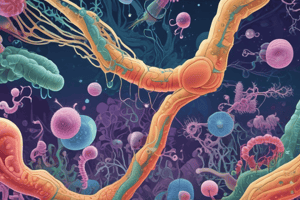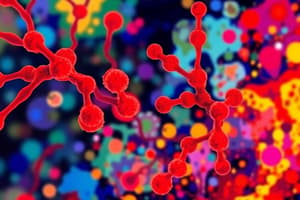Podcast
Questions and Answers
What is the primary function of Immunoglobulin G (IgG)?
What is the primary function of Immunoglobulin G (IgG)?
- Initiates the production of basophils
- Protects against parasitic worms
- Crosses the placenta to provide immunity to the fetus (correct)
- Activates immature T cells
What triggers the production of antibodies by the immune system?
What triggers the production of antibodies by the immune system?
- The presence of immunogens or antigens (correct)
- The activity of T-lymphocytes
- The presence of pathogens in the digestive system
- The absence of foreign molecules
Which immunoglobulin type is primarily involved in allergic reactions?
Which immunoglobulin type is primarily involved in allergic reactions?
- IgM
- IgE (correct)
- IgD
- IgA
Which application is NOT typically associated with immunoassays?
Which application is NOT typically associated with immunoassays?
What is an epitope?
What is an epitope?
What is the primary role of IgG in immunoassays?
What is the primary role of IgG in immunoassays?
How many amino acid residues are present in the heavy polypeptide chains of IgG?
How many amino acid residues are present in the heavy polypeptide chains of IgG?
What does the term 'epitope' refer to in immunology?
What does the term 'epitope' refer to in immunology?
Which of the following best describes a hapten?
Which of the following best describes a hapten?
What is the function of the paratope?
What is the function of the paratope?
In clinical diagnostics, which of the following is an example of a hormone tested?
In clinical diagnostics, which of the following is an example of a hormone tested?
Which of these applications does ELISA or EIA NOT typically serve?
Which of these applications does ELISA or EIA NOT typically serve?
What characterizes a continuous protein antigen?
What characterizes a continuous protein antigen?
What substance is commonly screened for in doping tests in cycling and horse racing?
What substance is commonly screened for in doping tests in cycling and horse racing?
Which of the following is NOT a drug of abuse mentioned for screening?
Which of the following is NOT a drug of abuse mentioned for screening?
What is the primary function of microneedle biosampling devices?
What is the primary function of microneedle biosampling devices?
How is blood ethanol concentration (BEC) related to ethanol consumption?
How is blood ethanol concentration (BEC) related to ethanol consumption?
Which of the following components provides the specific recognition of an antigen by an antibody?
Which of the following components provides the specific recognition of an antigen by an antibody?
What is one future application mentioned for multiplex plates?
What is one future application mentioned for multiplex plates?
In the context of immunoassays, what does an antibody do?
In the context of immunoassays, what does an antibody do?
Flashcards
Antibodies (Ab)
Antibodies (Ab)
Proteins produced in response to the presence of a foreign substance (antigen) in the body.
Antigen (Ag)
Antigen (Ag)
A foreign substance that triggers an immune response in the body, leading to the production of antibodies.
Paratope
Paratope
The specific part of an antibody molecule that binds to an antigen. It's the antibody's 'lock' that fits the antigen's 'key'.
Epitope
Epitope
Signup and view all the flashcards
Hapten
Hapten
Signup and view all the flashcards
Continuous Protein Antigen
Continuous Protein Antigen
Signup and view all the flashcards
Discontinuous Protein Antigen
Discontinuous Protein Antigen
Signup and view all the flashcards
ELISA
ELISA
Signup and view all the flashcards
Immunoassay
Immunoassay
Signup and view all the flashcards
Antigen
Antigen
Signup and view all the flashcards
Antibody (immunoglobulin)
Antibody (immunoglobulin)
Signup and view all the flashcards
Drugs of Abuse
Drugs of Abuse
Signup and view all the flashcards
Multiplex Immunoassay
Multiplex Immunoassay
Signup and view all the flashcards
Study Notes
Introduction to Immunoanalysis
- Immunoanalysis involves analytical methods using high-affinity, specific binding proteins.
- Immunoassays, including ELISA and EIA, use antibodies as specific binding reagents.
- These methods offer high affinity, specificity, and a variety of antibody binding reactions. They are routinely used in analysis and research.
- Applications include clinical diagnostics, food and environmental testing, forensics, pharmaceutical development and testing, and research.
Learning Objectives
- Describe and draw the basic structure of Immunoglobulin G (IgG): This will involve the details of the structure, including the number of identical light polypeptide chains (2), the number of amino acids in each light chain, the number of identical heavy polypeptide chains (2), the number of amino acids in each heavy chain, the variable (VL) and constant (CL) regions in the light chains, and the variable (VH) and constant (CH) regions in the heavy chains. The lecture will note chain connections with disulfide bonds or bridges. The molecular weight (150,000 or 150 kDa). There are 215 amino acids in the light chains and 420 amino acids in the heavy chains. The structure is described using a diagram.
- Define:
- Antibody (Ab): A protein that recognizes and binds to an antigen.
- Antigen (Ag): A substance that elicits an immune response and reacts with an antibody.
- Paratope: The region of an antibody that interacts with an antigen.
- Epitope (Antigenic Determinant): The region of an antigen that interacts with an antibody.
- Hapten: A low-molecular-weight molecule that is not antigenic by itself but can become antigenic when conjugated to a larger carrier molecule.
Antibodies
- The presence of an immunogen (antigen) triggers the immune system to produce antibodies.
- Antibodies are proteins that recognize and bind to these antigens.
- Antibodies are produced naturally by plasma cells in the host.
- The antibody-antigen (Ab-Ag) complex triggers other immune reactions to destroy the invading pathogen or foreign molecule.
- Plasma cells are differentiated B-lymphocytes, which are a type of white blood cell.
Types of Antibodies (Immunoglobulins - Ig)
- IgA: Found in mucous, saliva, tears, and breast milk; protects against pathogens.
- IgD: Found on immature B cells; activates basophils and mast cells.
- IgE: Protects against parasitic worms; responsible for allergic reactions.
- IgG: Secreted by plasma cells in the blood; can cross the placenta; involved in later stages of immunity.
- IgM: Found on the surface of B cells or secreted into the blood; responsible for early stages of immunity.
IgG - Predominantly used in Immunoassays
- IgG is a 150,000 Dalton (or 150 kDa) molecule.
- It contains two identical light polypeptide chains and two identical heavy polypeptide chains.
- Each of the light chains has 215 amino acid residues and a variable (VL) and a constant (CL) region.
- Each of the heavy chains has 420 amino acid residues and a variable (VH) and three constant (CH1, CH2, CH3) regions.
- Chains are linked by disulfide bonds.
Definitions - Antigen (Ag) and Epitope
- Antigen (Ag): A substance that elicits an immune response and reacts with an antibody.
- Epitope (Antigenic Determinant): The specific region of an antigen that interacts with the antibody. Epitopes can be continuous (linear), or discontinuous (conformational).
Definitions - AA and Paratope
- Protein Antigen (AA):
- Continuous: Stretch of amino acids (AAs) directly linked in the protein sequence.
- Discontinuous: AAs are separate from one another in the primary linear sequence.
- Paratope (Antigen Binding Site): Composed of 50 amino acid residues across both variable segments of the heavy and light chains of the antibody.
Definitions - Hapten
- A hapten is a low molecular weight molecule that is not antigenic on its own.
- It can be conjugated to a carrier protein to induce an immune response allowing its detection using an antibody.
Diagnostic tests - Basic principles – ELISA or EIA
- Direct ELISA: Primary antibody binds directly to antigen.
- Indirect ELISA: Detects antigen using a secondary antibody reagent, which is attached to a detectable marker or signal.
- Sandwich ELISA: Detecting antigen using two different antibodies that bind to different epitopes of the same antigen.
- Competitive ELISA: Detects antigen by the competition between added antigen and an antigen in a sample. If there is less antigen in the sample, more of the added antigen will bind.
Group Activity - Applications
- Clinical Diagnostics
- Food & Environmental Testing
- Forensics
- Pharmaceutical Testing
- Research
Applications – Clinical diagnostic tests
- Example: Rapid antigen testing, for SARS-CoV-2
- Example: Hormone testing (e.g., human chorionic gonadotropin (hCG))
- Example: Hormone testing (e.g., Troponin I)
Applications - clinical diagnostic applications
- Includes detection of antibodies to HIV by ELISA.
- Includes detection of antigens to HIV by ELISA.
Applications – Food & environmental testing
- Detection of pathogens like Serratia marcescens in food or environmental samples.
- Testing of pork extracts for different contaminants
Applications – Forensics
- Detection of doping agents like erythropoietin (EPO) in cycling and horse racing.
Applications – Pharmaceutical testing
- Example: Screening for "drugs of abuse": THC, cocaine, opiates, fentanyl, cathinones, benzodiazepines, barbiturates.
- Testing blood ethanol concentrations (BEC).
Future Applications - Multiplex plates and Biochips
- Multiplex plates: Use of multiple antibodies to detect multiple antigens on one plate at once.
- Biochips: Contain millions of biosensors which takes advantage of new developments in microfluidics and bioengineering to perform analyses.
Design of microneedle biosampling devices
- Use hollow chitosan microneedles for interstitial fluid (ISF) sampling. This then allows for analysis via 3D electrochemical paper analytical devices (3D ePADs). These devices can detect multiple biomarkers.
Learning Objectives (Additional notes from page 19)
- Give examples of a range of applications: The presented topics.
- Describe and draw the basic structure of IgG: The notes provided.
- Define: As defined in the earlier sections of the notes.
Studying That Suits You
Use AI to generate personalized quizzes and flashcards to suit your learning preferences.




